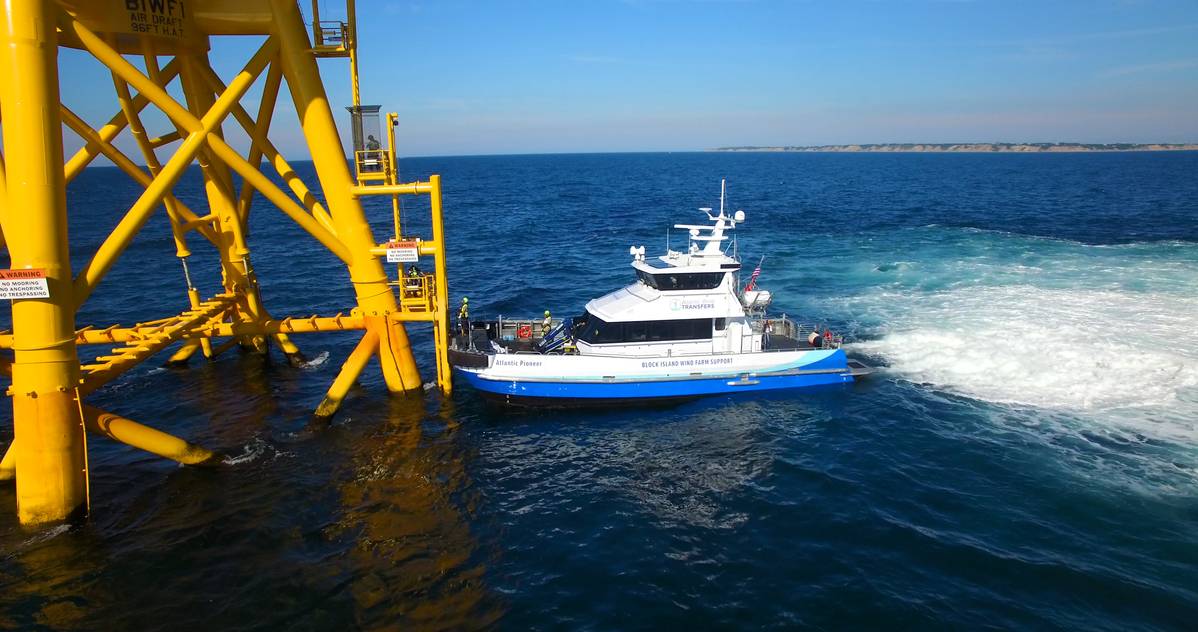Crew Transfer
Vessels
Crew Transfer Vessels: Building the US Fleet
A fleet of Jones Act compliant crew transfer vessels is growing in stride with the United States’ burgeoning offshore wind industry.
By Eric Haun
When the United Sates’ first purpose-built crew transfer vessel (CTV), Atlantic Pioneer, was delivered in 2016, the country’s offshore wind industry was just getting off the ground. In the years that followed, the industry has been building up—perhaps slower than expected at times—but today is moving forward in earnest.
Coinciding with this build-up is the growth of a fleet of Jones Act qualified vessels, including newbuilds and conversions, to service this nascent industry. Among these are CTVs, which ferry personnel and light equipment to support the construction and long-term service of offshore wind farms.
Today, nearly 30 of these vessels are in service, under construction or on order in the United States, and it is expected that dozens more will be built in the years ahead as more wind farms take shape in U.S. waters.
In-service newbuilds
Atlantic Pioneer, built by Blount Boats in Warren, R.I., for Atlantic Wind Transfers (AWT) was literally the pioneer, built for America’s first commercial wind farm off of Block Island, where it remains in service today.

The next U.S.-built CTV to come along was the WindServe Odyssey, delivered by North Kingstown, R.I. shipbuilder Senesco Marine for sister company WindServe Marine in 2020, followed by another Blount-built boat, Atlantic Endeavor, again for AWT, handed over in 2021.
In 2023, Senesco delivered two more vessels for WindServe Marine: WindServe Genesis and WindServe Journey; and Gulf Craft in Franklin, La. delivered WINDEA Intrepid for WINDEA CTV, a partnership between Hornblower Wind and MidOcean Wind.
Palatka, Fla. shipyard St. Johns Ship Building in January of this year announced its first CTV delivery: WINDEA Courageous for WINDEA CTV. In March, Blount delivered Gripper, the first CTV for American Offshore Services (A-O-S), a joint venture formed in 2020 by leading European CTV operator Northern Offshore Services (N-O-S) and U.S.-based investment firm OIC.
On order and under construction
There are many more CTVs on order and under construction at U.S. shipyards, including the aforementioned yards, as well as Gladding-Hearn Shipbuilding in Somerset, Mass.; Breaux Brothers in New Iberia, La.; and Metal Shark in Franklin, La. Other shipyards such as Platypus Marine in Port Angeles, Wash. have agreements in place to build CTVs, but firm orders are yet to be confirmed.
The next CTV expected for delivery is another WINDEA vessel, WINDEA Enterprise, which started sea trials in June, according to builder St. Johns Ship Building. Other CTVs scheduled for delivery this year include AWT’s Atlantic Resolute—also at St. Johns—as well as WindServe Marine’s WindServe Enterprise at Senesco and a yet-to-be-named CTV for Patriot Offshore at Gladding-Hearn.
Firm CTV orders in the books of U.S. shipyards have scheduled delivery dates through 2026, and there more than a dozen options rumored or known to exist.
Design and specifications
Leading designers of the United States’ newbuild CTV fleet include Incat Crowther, NOS, Chartwell Marine and BMT. The aluminum catamarans range in size from 19.7 meters to 30 meters long (LOA), with beams ranging from about 7 meters to 11 meters. The vast majority have capacity for up to 24 passengers and are generally manned by a crew of six to eight.
To date, all CTVs ordered in the U.S. are diesel mechanical, though a handful are described as “hybrid-ready”, meaning they are built with space to accommodate a potential conversion to hybrid propulsion in the future. Most of the vessels delivered and on order are powered by Volvo Penta engines paired with IPS propulsion, while one owner with eight vessels in total, including options, has opted for MAN engines, including two with HamiltonJet waterjets and the remainder with CPP. Two vessels in the U.S. CTV fleet are powered by Scania engines, both with HamiltonJet waterjets.
Conversions
Several existing vessels have also been converted to gain new life as a CTV within the U.S. offshore wind sector. For example, in 2023, Hornblower Marine announced it converted the former offshore supply vessel (OSV) Gateway Endeavor at its facility in Bridgeport, Conn. for WINDEA. Hornblower also converted former fishing vessel Nice Day Too for Coast Line Transfers. Now a CTV, the vessel has been renamed Capt. Les Eldridge.
